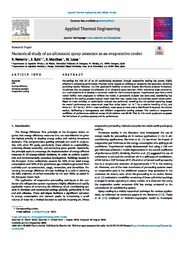Please use this identifier to cite or link to this item:
https://hdl.handle.net/11000/35396Full metadata record
| DC Field | Value | Language |
|---|---|---|
| dc.contributor.author | Navarro Cobacho, Pedro | - |
| dc.contributor.author | Ruiz Ramírez, Javier | - |
| dc.contributor.author | Martínez, Pedro Juan | - |
| dc.contributor.author | Lucas Miralles, Manuel | - |
| dc.contributor.other | Departamentos de la UMH::Ingeniería Mecánica y Energía | es_ES |
| dc.date.accessioned | 2025-01-28T13:41:32Z | - |
| dc.date.available | 2025-01-28T13:41:32Z | - |
| dc.date.created | 2024 | - |
| dc.identifier.citation | Applied Thermal Engineering | es_ES |
| dc.identifier.issn | 1873-5606 | - |
| dc.identifier.issn | 1359-4311 | - |
| dc.identifier.uri | https://hdl.handle.net/11000/35396 | - |
| dc.description.abstract | Pre-cooling the inlet air of an air conditioning condenser through evaporative cooling has proven highly effective in enhancing performance. Previous works focused on utilising an ultrasonic mist generator, obtaining promising results. However, the mist generator’s inability to control droplet distribution presents limitations. To address this, we propose the utilisation of an ultrasonic spray atomiser, which overcomes these constraints. Our main objective is to develop a numerical model for this innovative system. Experimental data from a wind tunnel facility were employed to validate the model. A parametric analysis was conducted, considering key variables in the cooling process: injected water mass flow rate, cooled area, and atomiser power consumption. Based on these variables, an optimisation analysis was performed, revealing that the optimal operating ranges for overall performance are water-to-air mass flow ratios below for a relative humidity of 0.5, and below for 0.7. Within these conditions, water spray is more evenly distributed throughout the control section, facilitating a homogeneous and efficient evaporative cooling process. The maximum evaporative coefficient of performance achieved across all simulations was 30.49. That is, this novel equipment surpasses the limitations of previous systems and its performance. | es_ES |
| dc.format | application/pdf | es_ES |
| dc.format.extent | 14 | es_ES |
| dc.language.iso | eng | es_ES |
| dc.publisher | Elsevier | es_ES |
| dc.relation.ispartofseries | 236 | es_ES |
| dc.rights | info:eu-repo/semantics/openAccess | es_ES |
| dc.rights | Attribution-NonCommercial-NoDerivatives 4.0 Internacional | * |
| dc.rights.uri | http://creativecommons.org/licenses/by-nc-nd/4.0/ | * |
| dc.subject | CFD | es_ES |
| dc.subject | Cooling efficiency | es_ES |
| dc.subject | Ultrasonic atomiser | es_ES |
| dc.subject | Evaporative cooling | es_ES |
| dc.subject.other | CDU::6 - Ciencias aplicadas::62 - Ingeniería. Tecnología::621 - Ingeniería mecánica en general. Tecnología nuclear. Electrotecnia. Maquinaria | es_ES |
| dc.title | Numerical study of an ultrasonic spray atomiser as an evaporative cooler | es_ES |
| dc.type | info:eu-repo/semantics/article | es_ES |
| dc.relation.publisherversion | https://doi.org/10.1016/j.applthermaleng.2023.121455 | es_ES |

View/Open:
2024 ATE 236.pdf
2,98 MB
Adobe PDF
Share:
.png)
